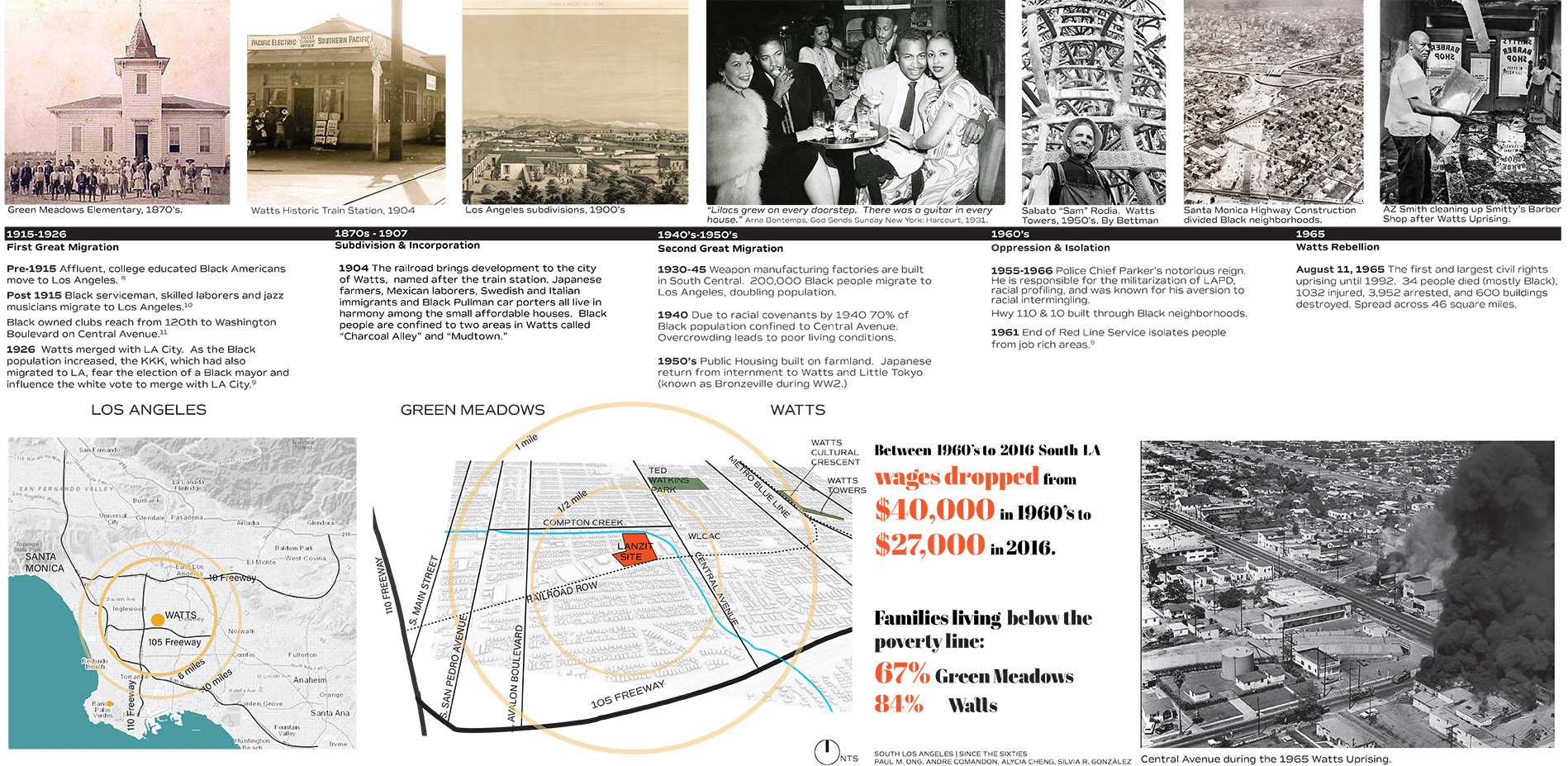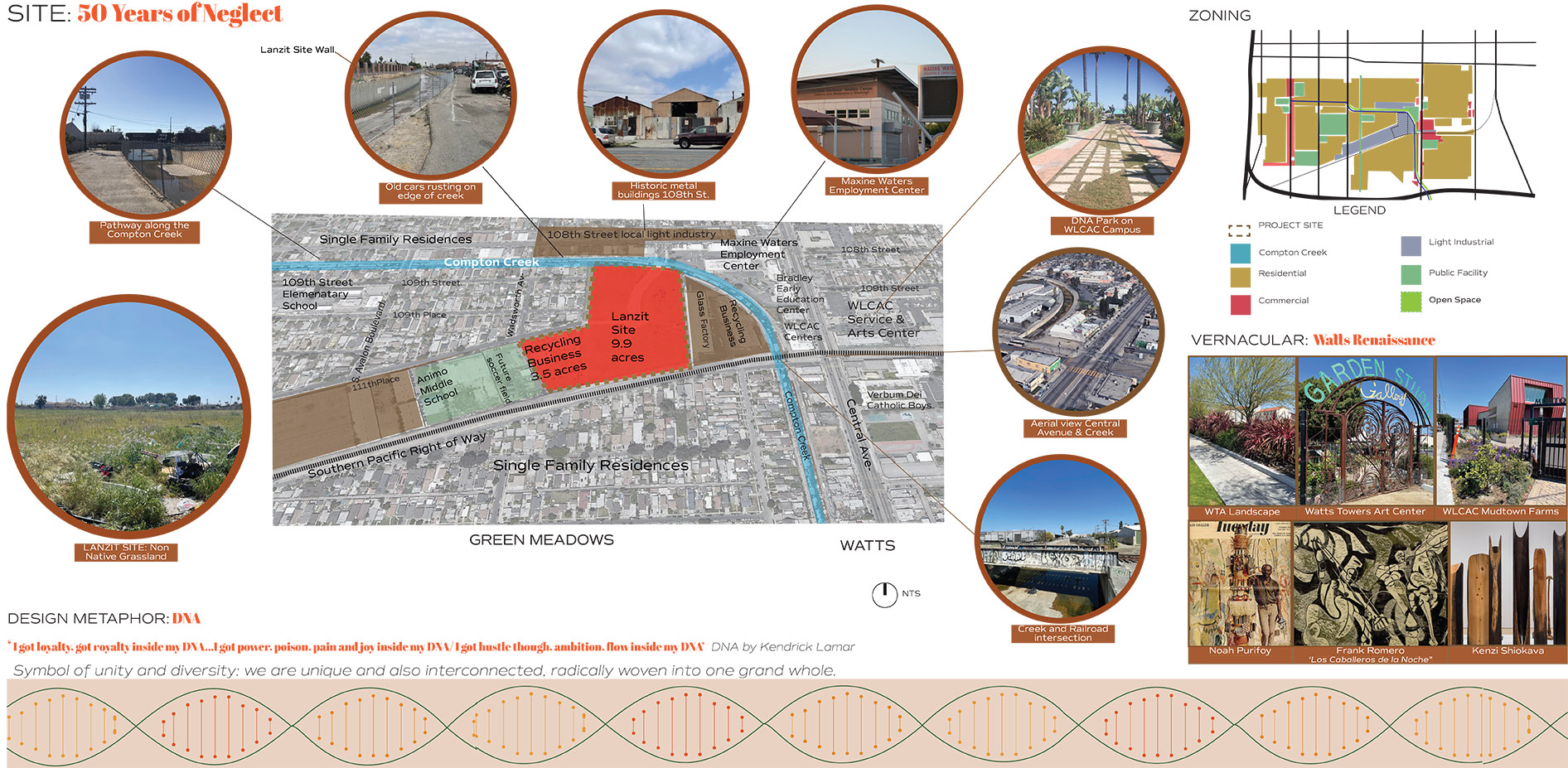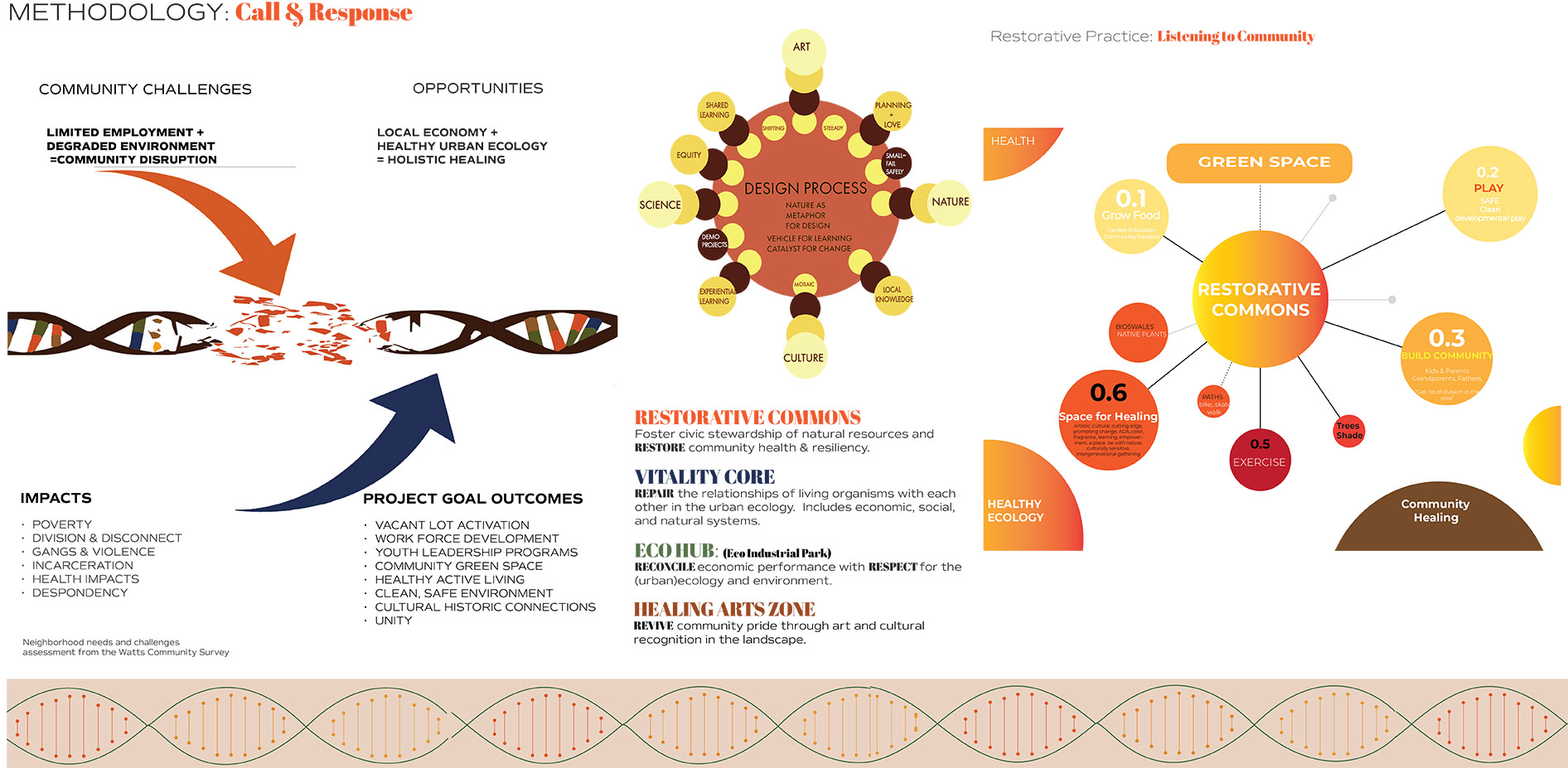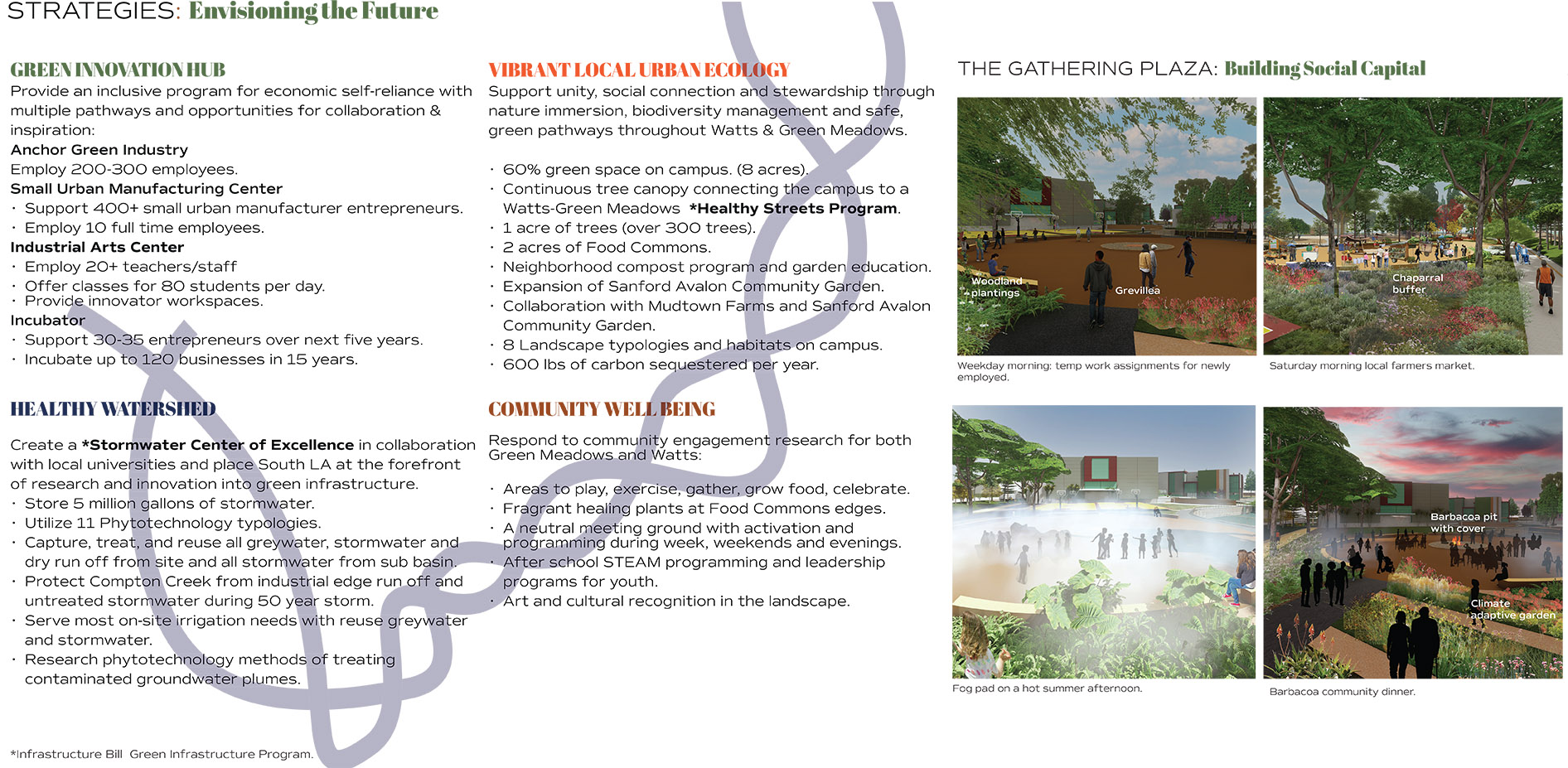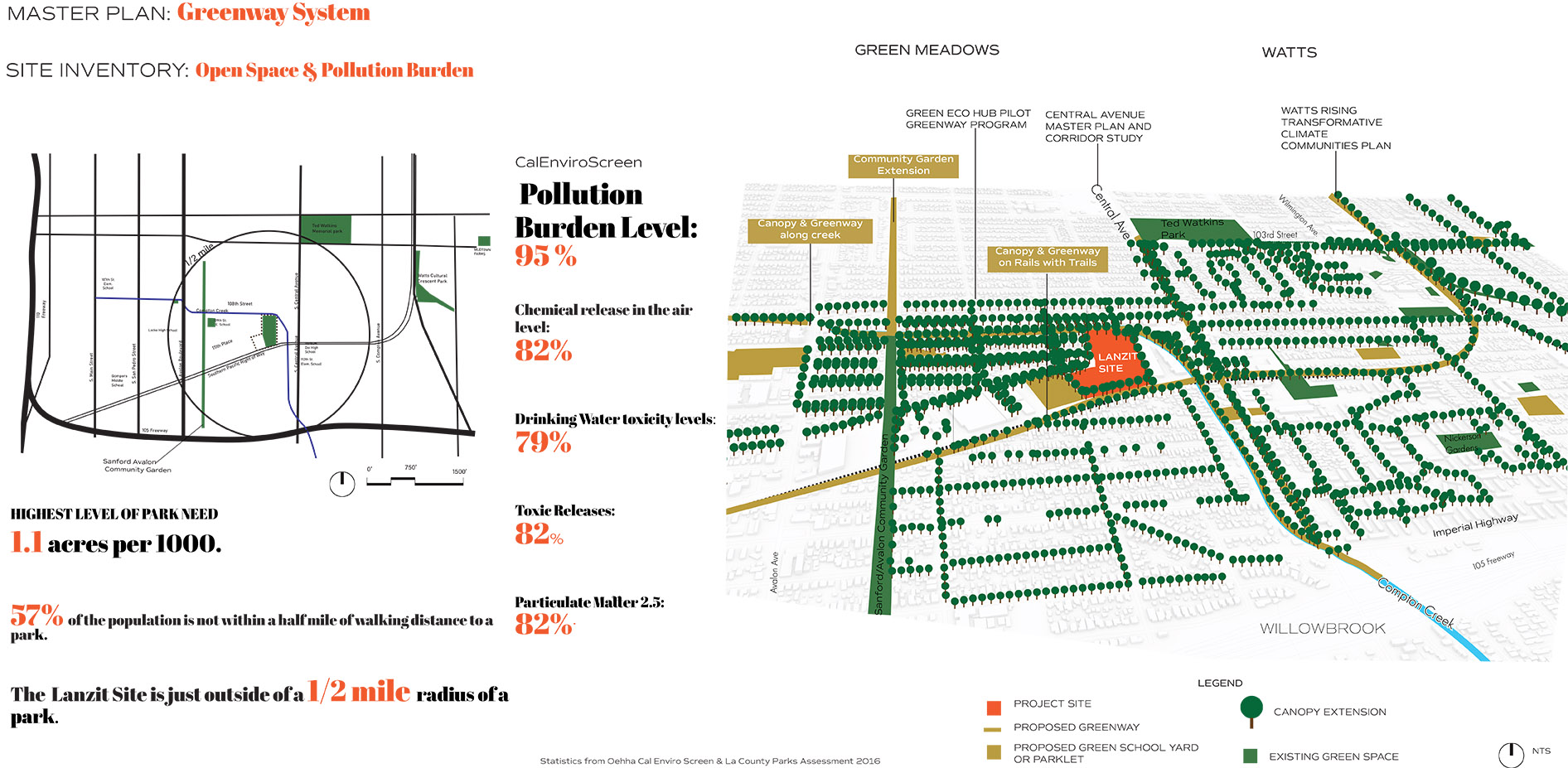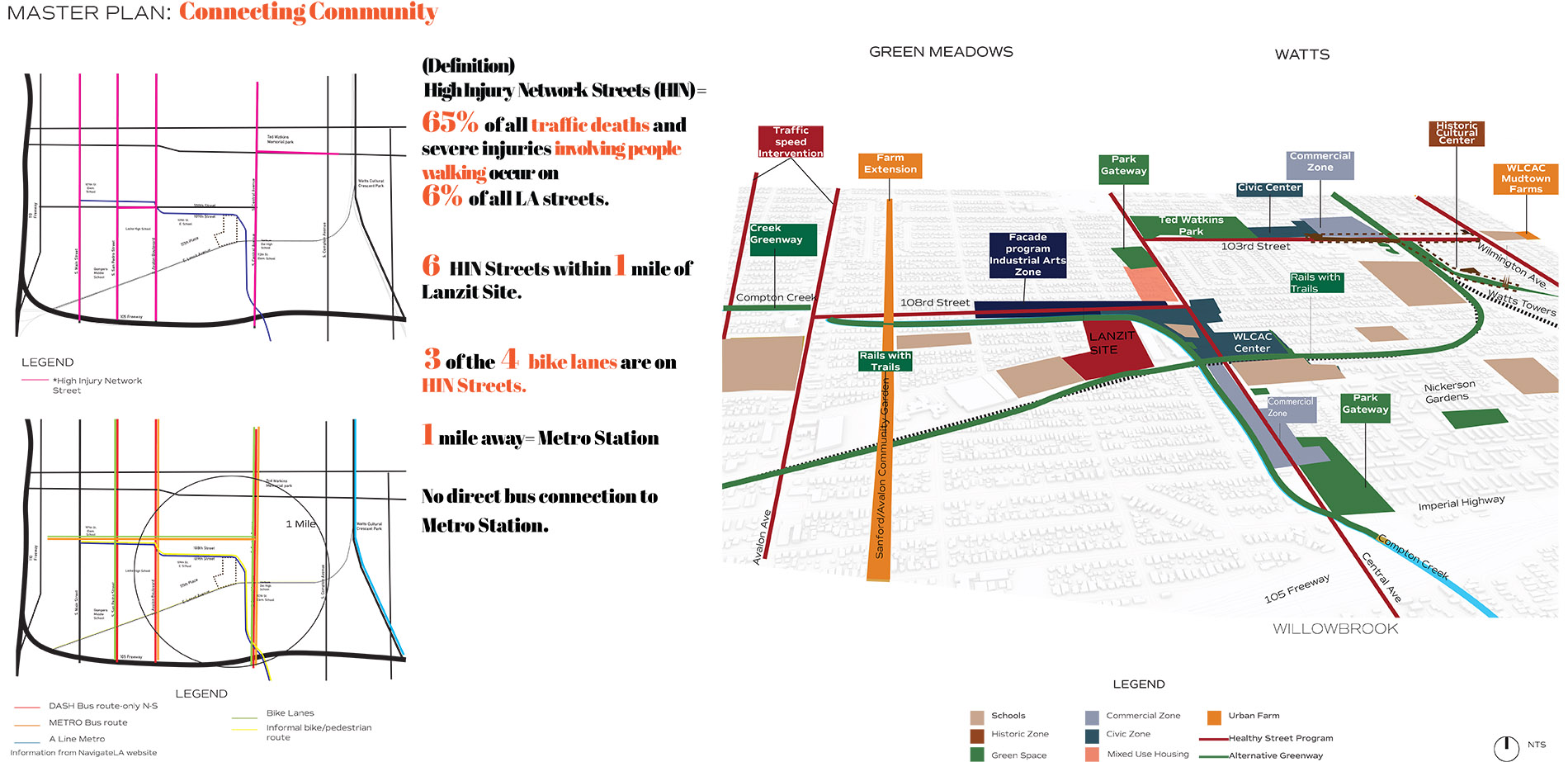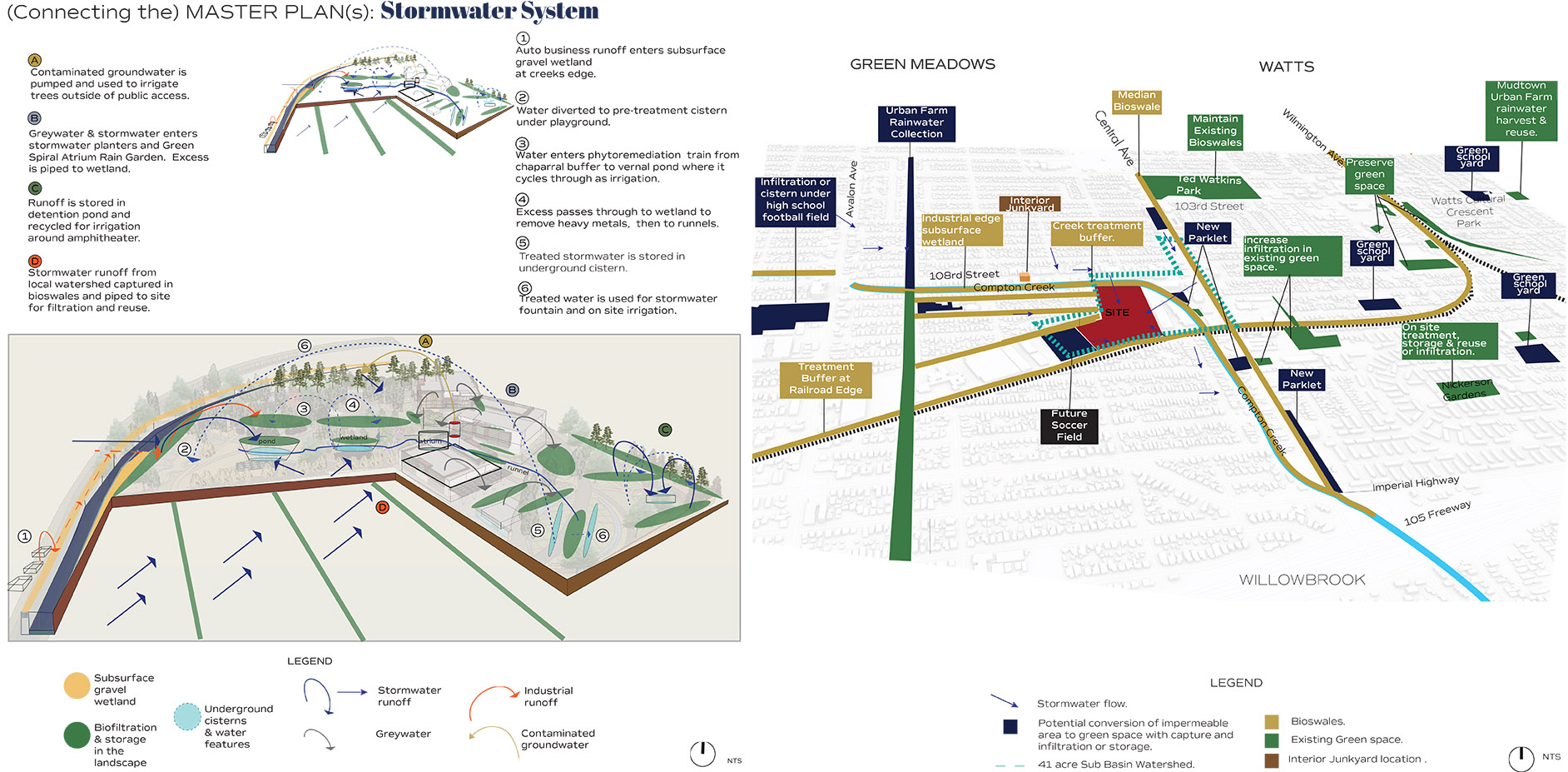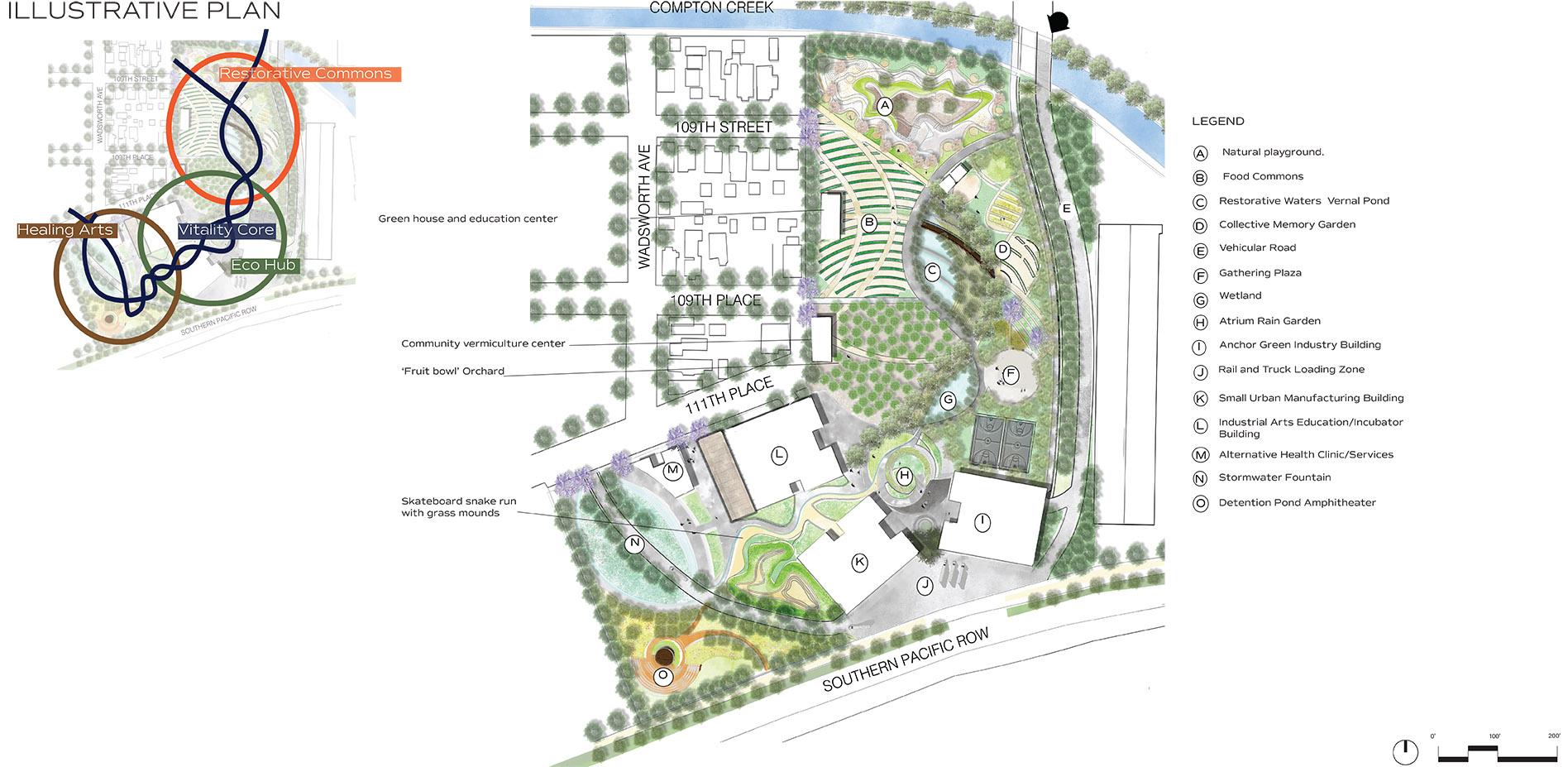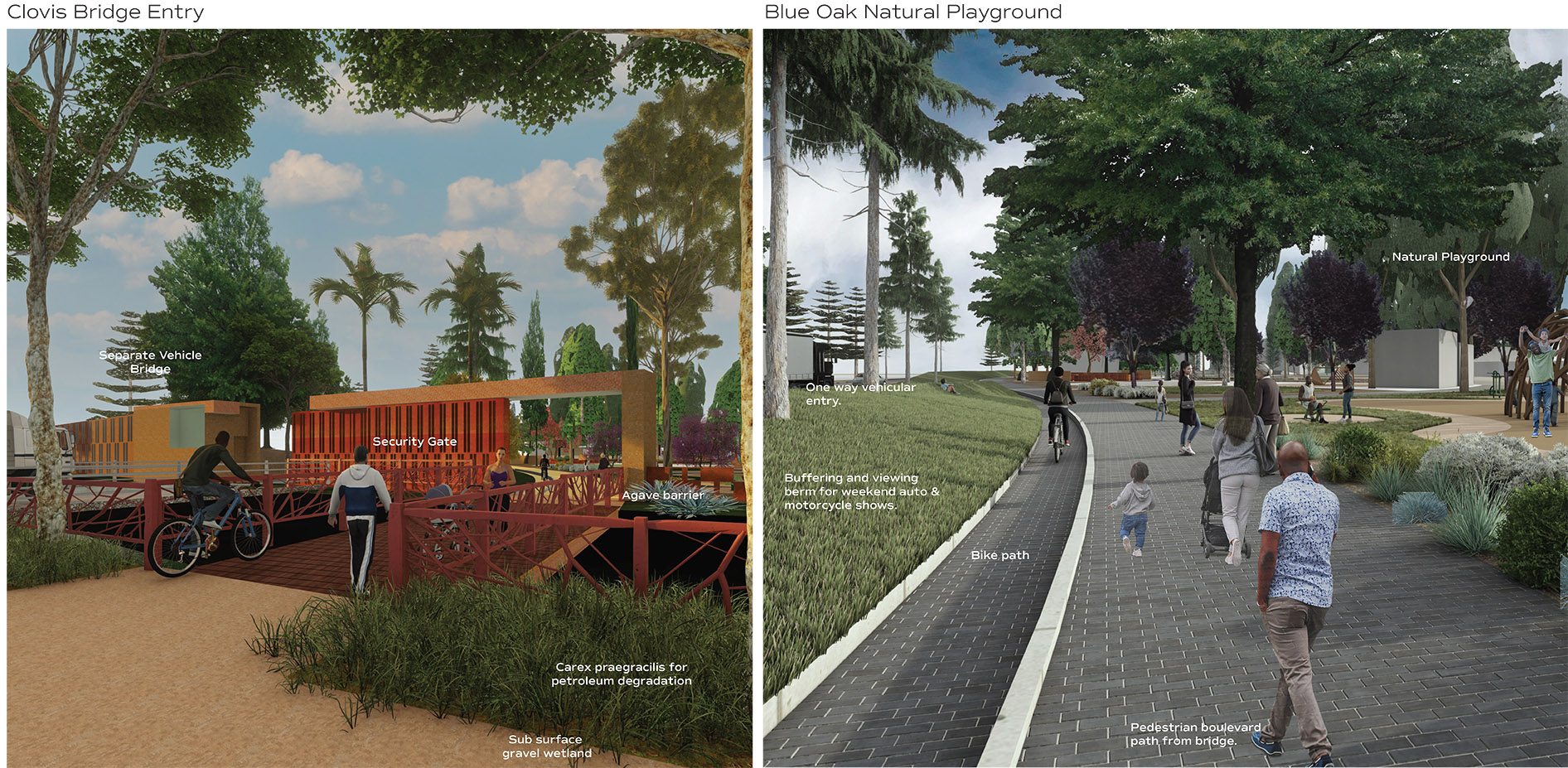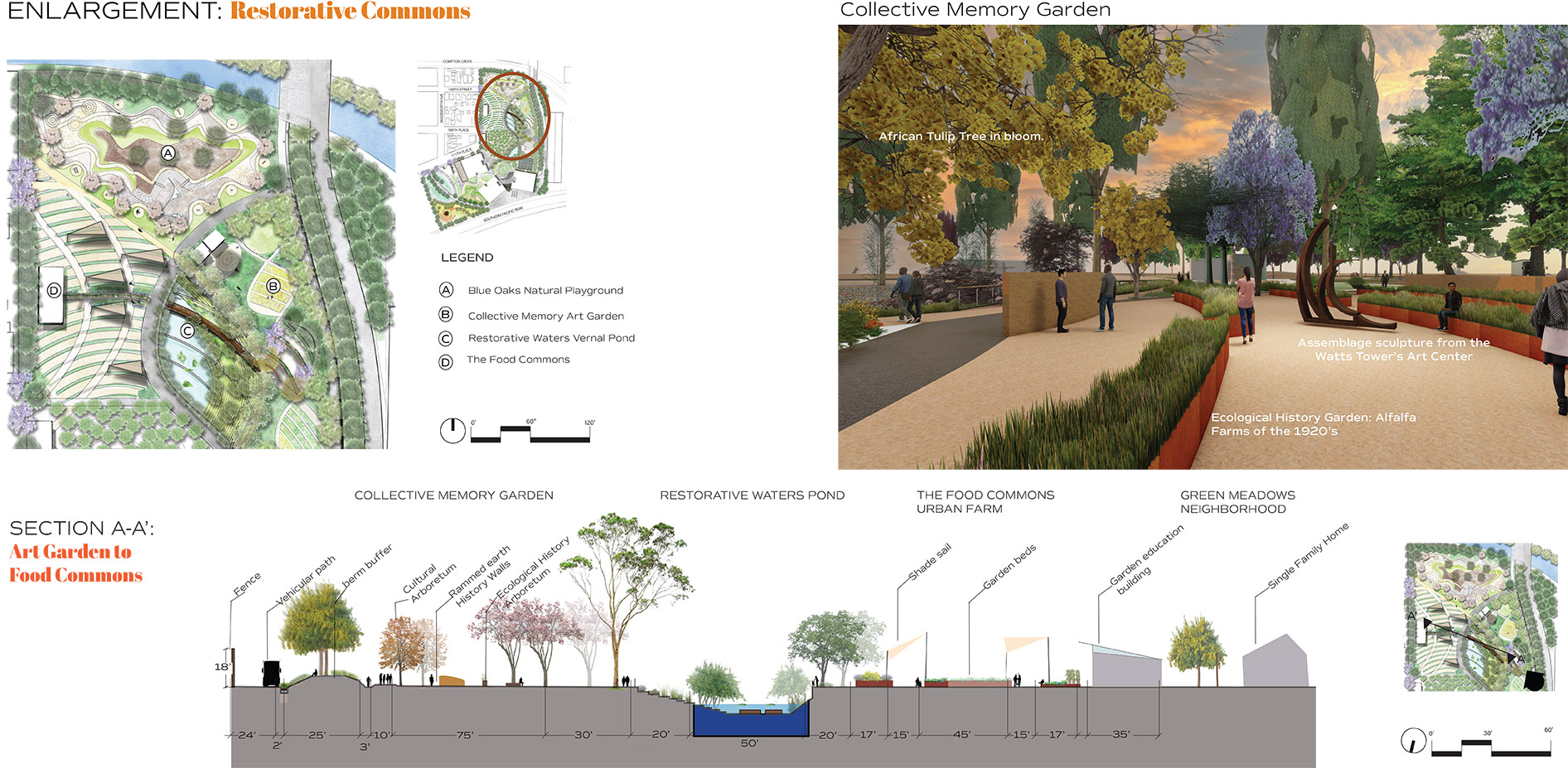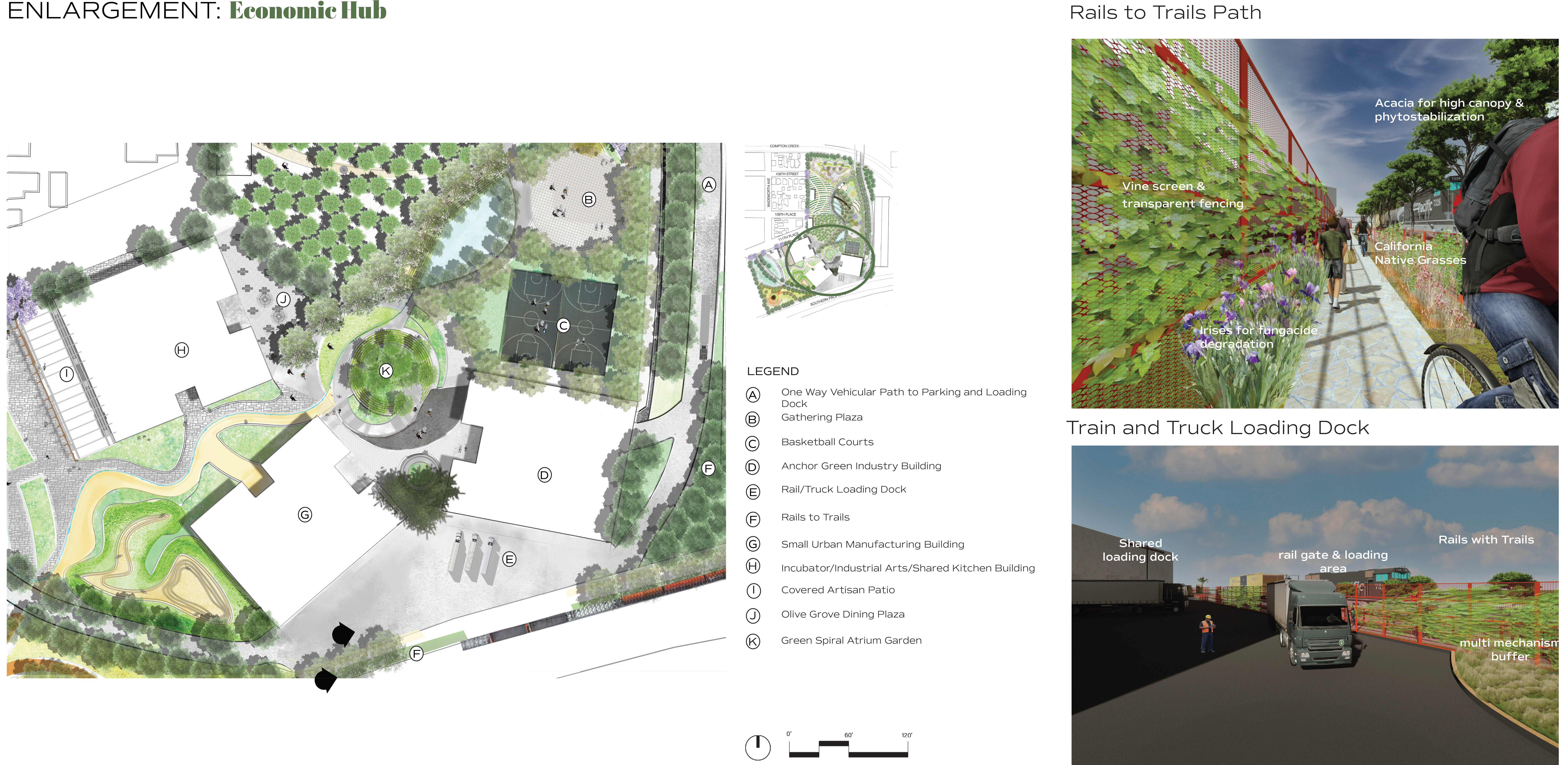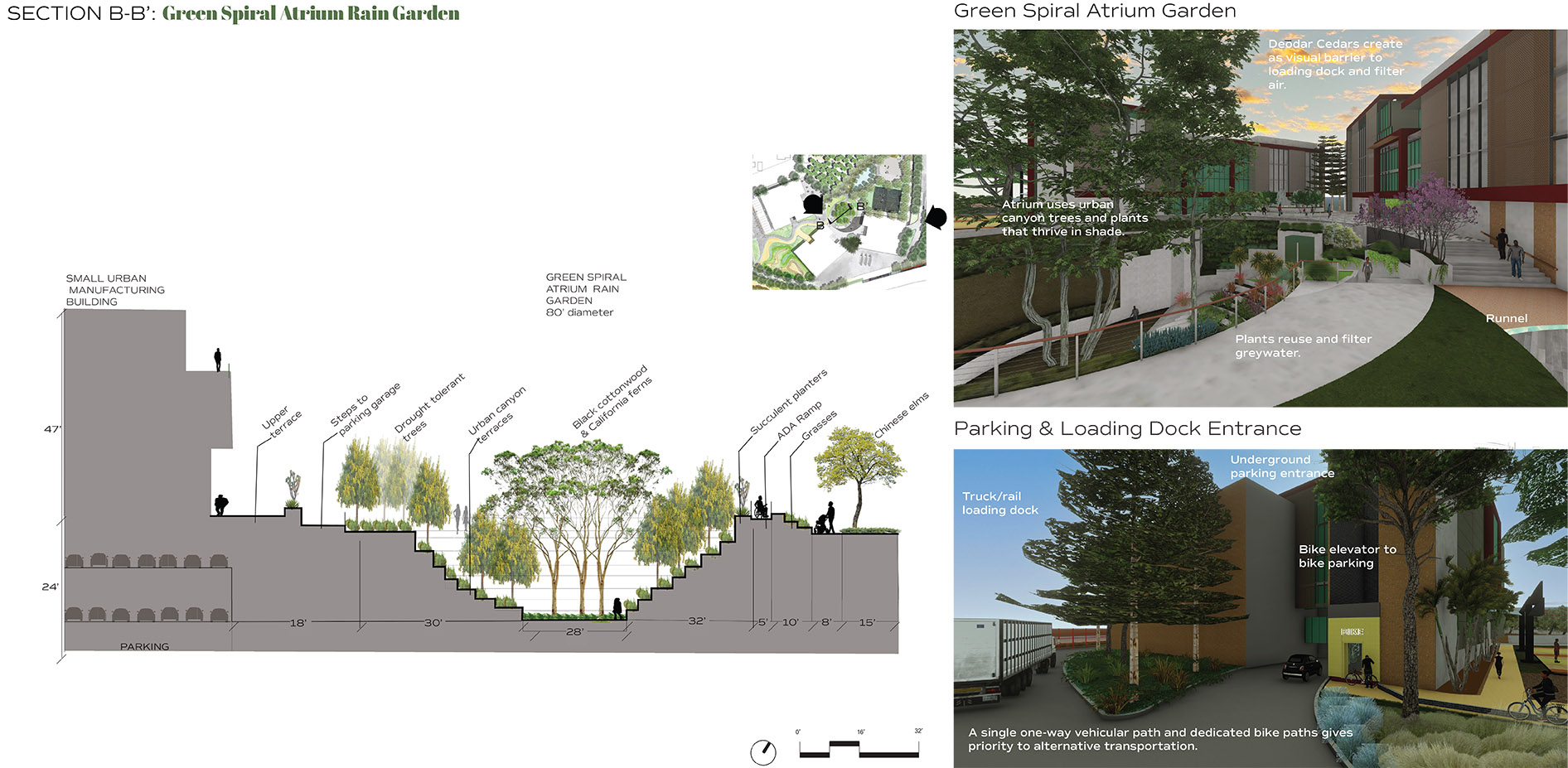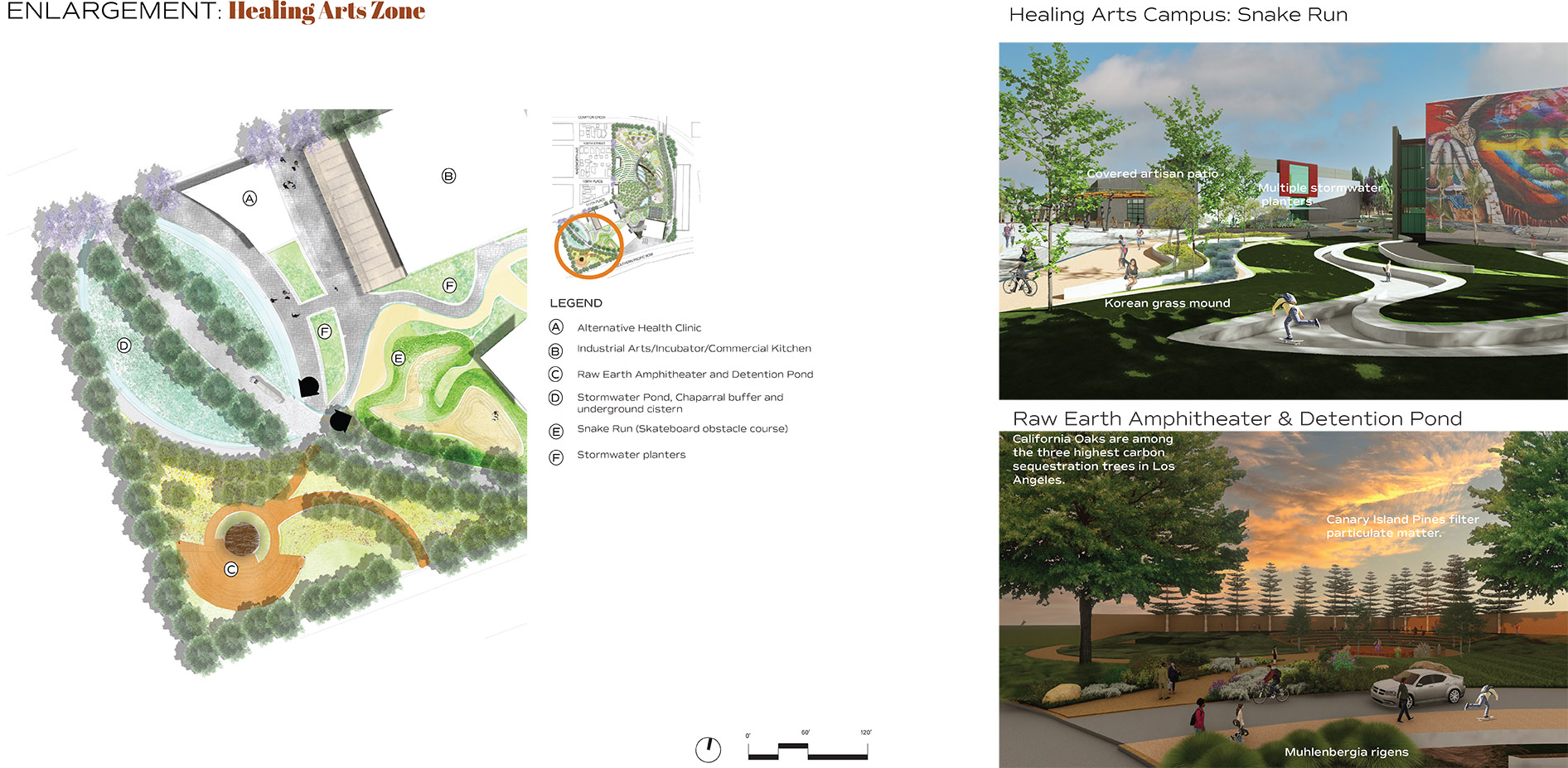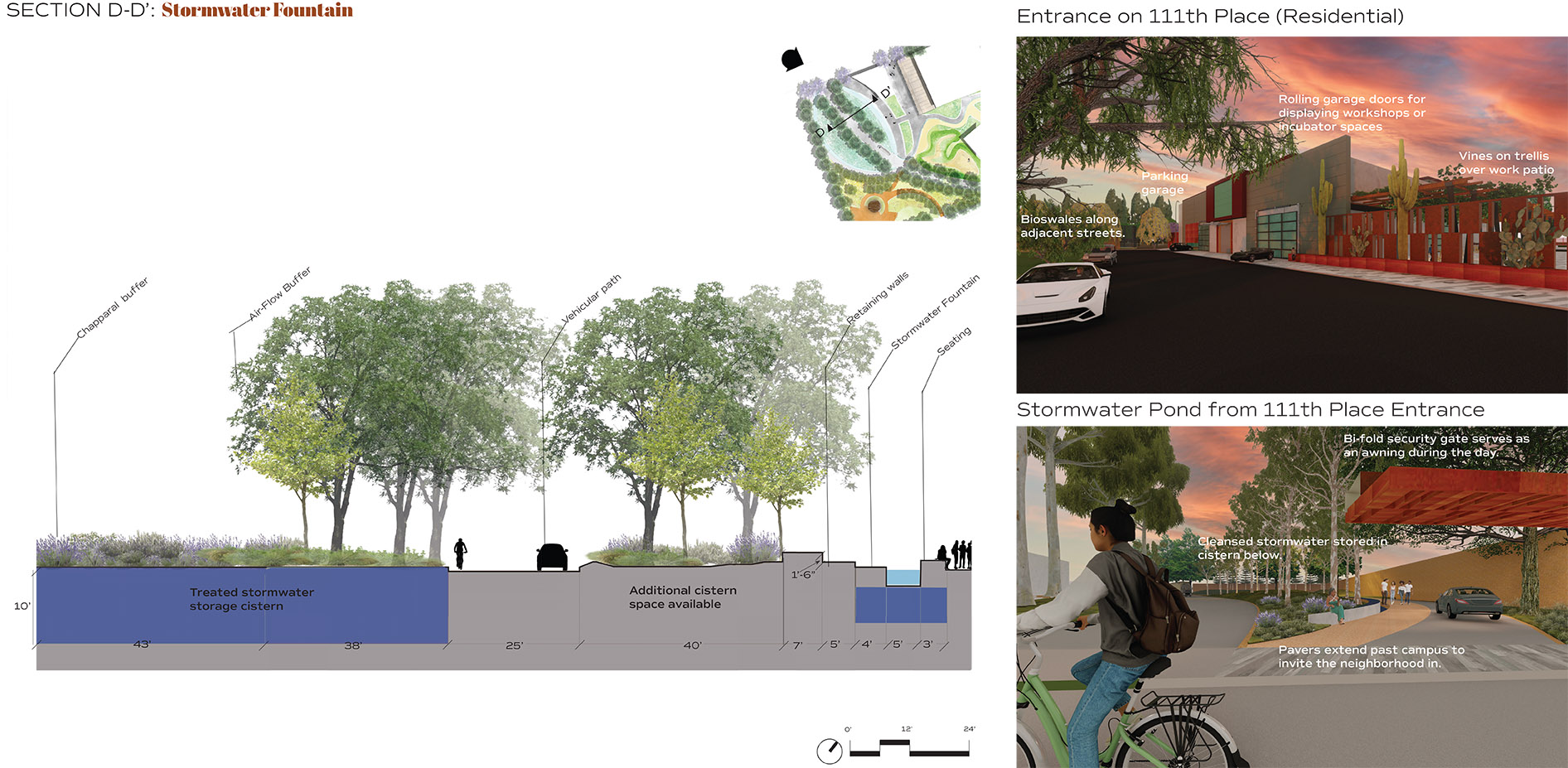A Vision for Reparations: Reimagining the Eco Industrial Park for South LA
Honor Award
Urban Design
Los Angeles, California, United States
Alyssa Leal- Moffitt, Student ASLA;
Faculty Advisors:
Pamela Brief, ASLA;
Meg Coffee;
Jim Pickel, ASLA;
University of California Los Angeles Extension
We were impressed by the commitment to ecojustice, the tangible data in the background research and extra level of community engagement. The campus masterplan was well-developed with sensitivity to ecology and responding to the neighborhoods' call for spaces to heal, celebrate, and collaborate.
- 2022 Awards Jury
Project Credits
Tim Watkins
CEO, Watts Labor Community Action Committee/ Community Collaborator, Program Developer
Project Statement
How can landscape architecture play a role in repairing the impacts of structural racism in post-industrial landscapes? This project imagines how the Infrastructure Investment and Jobs Act could fund an eco-industrial park in South LA , thus providing economic opportunity while addressing the need for ecological and social well-being where the consequences of industry on race and poverty are most profound.
The project site is a former brownfield in South LA in two neighborhoods that have experienced the highest impacts of pollution, incarceration, and governmental neglect. The core program is a holistic, restorative commons embedded in a center of innovation and green industry with programs that intertwine to create new cycles of opportunities for economic self-reliance, well-being, and celebration of local art and culture. A highlight of the project is a Stormwater Center of Excellence where the multi-university collaborative Better Watts Initiative leads the community in phytotechnology research to address point and non-point pollution of the Compton Creek, the site's contaminated groundwater plume, as well as addressing lead contamination of the drinking water.
Project Narrative
As the nation reckons with an unreconciled past, issues around governmental inaction toward toxic sites and economic exclusion continue to impact Black and Brown Communities. As a result of mid-century redlining practices, many communities of color exist within post-industrial lands and suffer the strongest impacts of our current health, economic, and climate crises. The central challenge is to reconcile the need for economic inclusion with the health of urban ecosystems. Through the design of an eco-industrial park on a former brownfield in South LA, the design proposes a green innovation hub to support economic self-reliance, heal an impaired watershed, and inspire community well-being through a restorative commons, within a vibrant local urban ecology.
The project site is a former Cal Trans maintenance yard, the Lanzit Site, that borders the South Pacific Railroad Right of Way and the Compton Creek. The project incorporates the 9-acre Lanzit Site and an adjacent 4-acre junkyard. It is located at a crucial point along the impaired Compton Creek within the neighborhood of Green Meadows at the border of Watts. This part of the Compton Creek is not included in the LA River Master Plan, in spite of the local industrial impact on the health of the creek and the neighborhoods' critical need for connection and nature immersion. It is within walking distance of local schools and young people who deserve to decide the future they would like to steer towards. It is a tabula rasa that has the potential to support a mosaic of programs that bring diverse people together to experiment with economic, social, and environmental models that are small enough to fail, thereby paving new pathways to success.
The classic definition of an eco-industrial park is a cluster of industries on several hundreds of acres with a closed-loop cycle whereby the waste of one industry is the base material for another. Benefits to local communities and a focus on park management are also within its scope. However, I sought a definition that would focus more on the benefits for this specific urban ecosystem and would fit into the two neighborhoods like the missing piece of a puzzle. In "Industrial Ecology as Ecological Design: Opportunities for (re) Discovery" Dr. Nina Lister calls for "engaging in the social dimension" and exploring the potential of an eco-industrial park to become "an agent of..personal and societal transformative changes." (p.16)
Community engagement was not within the scope of this student project, but during the 2 year period prior to my capstone, I was inspired to embark on a long-term, personal commitment modeled by Dr. CL Bohannon's work at Virginia Tech. I attended neighborhood council and other community engagement meetings to listen to and understand the most pressing concerns. I worked with activists on issues around gentrification and pollution. I studied Restorative Practices and Justice with the International Institute for Restorative Practices to inform my listening skills. This personal involvement in activism on local concerns around park equity and environmental health gave me insights into the deep trauma caused by decades of constant struggle for economic and ecological justice. But this time was also personally enriching where I had the honor to spend time with welcoming, hospitable, and very knowledgeable folks.
All of the restorative commons programs and goals are direct reflections of local wisdom and voices around the integrity of the natural and built environment as well as the holistic well-being of the communities and individuals. The site is organized around 4 zones that represent the goals of the project: the Restorative Commons, the Vitality Core, the Green Economic Hub, and the Healing Art Zone. These zones are interlinked by a phytoremediation chain that is in the form of a double helix DNA Chain. It is symbolic of the intertwining of programs and people, past, present, and future, that together create new chains of sequences that lead to resilience and fulfilled potential.
RESTORATIVE COMMONS
The commons represent both the natural systems (water, air, soil, forests, oceans, etc) and the cultural patterns and traditions (intergenerational knowledge ranging from growing and preparing food, medicinal practices, arts, crafts, ceremonies, etc), that are shared without cost by all members of the community.
-Ecojustice Dictionary 2008
The Los Angeles Neighborhood Land Trust's Park Equity Leadership Academy (PELA), is a 10-week session engaging local leadership for park advocacy in the Green Meadows neighborhood and was a vital source of community voices. Local wisdom was reflective of established theories in therapeutic landscapes, trauma-informed design, and multidisciplinary understanding of what is essential for building local social capital and healing neighborhoods. The programs derived from these voices include a natural playground, a walking loop, a Food Commons with garden education, and a community compost center.
VITALITY CORE
The soil of the Lanzit Site has been remediated yet a groundwater contamination plume with an undetermined spread still remains. Ongoing pollution from the nearby junkyard railroad and locally-owned auto shops on the edge of Compton Creek are also potential point pollution sources, according to The Lanzit Sites 23021 Semi-Annual Groundwater Monitoring Report. The Stormwater Center of Excellence would include a closed-loop, holistic watershed plan to intertwine stormwater capture within the local watershed, phytoremediation at the edges of the auto businesses and railroad, and water reuse in the landscape. The site offers a space for the university partners of the Better Watts Initiative to collaborate with the community in the research and development of groundwater and stormwater treatment. The phytoremediation chain also visibly demonstrates the cleansing process and defines the campus circulation system.
ECO HUB
The economic model was defined by the Watts Labor Community Action Committee (WLCAC), the largest and oldest non-profit service provider and developer in Watts that has been dedicated to Black and Brown economic self-reliance since 1965. The WLCAC program includes an anchor green industry that provides the initial investment and job opportunities, a small urban manufacturing shared space for entrepreneurs, an industrial arts and education center, a community kitchen, and an incubator program. WLCAC has a 55-year history of working with the formerly incarcerated whose exclusion from the economy and society has deep repercussions throughout South LA. They designed a flexible and inclusive job entry program that cycles people into living wages jobs and entrepreneurship. The Eco Hub takes advantage of the railroad adjacency for the greener transport of goods and materials and provides a Rails-with-Trails for pedestrians and bicyclists. The WLCAC Plan also inspired the Food Commons and the Center for Alternative Health found in the other zones.
HEALING ARTS
Healing is addressed through alternative health, gathering, communal dining, performance, and celebration. Art installations are mixed with cultural and ecological history garden exhibits that memorialize the Collective Memory of the land and the people, from the earliest Chumash land stewards to the Black jazz musicians of the First Great Migration, the Japanese farmers who grew strawberries before the Japanese-American internment, to the Mexican and Italian laborers, like Simon Rodia, who created the Watts Towers as a gift to his beloved neighbors. A public plaza serves as a gathering place for new workers, The Food Commons Farmers Market, and a place for cultural events to allow for different voices within the landscape and demonstrate a 'shifting, steady mosaic' that is the new understanding of ecology. This mosaic draws from the vernacular of local art and culture and is reflected in the materials (and the graphics) that reflect the vibrancy and warmth of South LA.
Collaboration here is fundamental: it is the economic model of sharing machinery in a small urban manufacturing center, the experimental play in the nature playground, and the backbone of the Food Commons. It is the starting point with ongoing community engagement at its heart. "(Re) discovery, (re) creation, (Re) consideration, (re) affirming" and reconciling differences between cultures, neighbors, and disciplines are part of a process defined as "planning + love."
Plant List:
- Astralagus nuttalli /iNutall's milkvetch
- Sambucus mexicana/Mexican Elderberry
- Fragaria vesca/California strawberry
- Spathodea campanulata/African Tulip Tree
- Baccharis pilularis 'Pozo Surf'/ lowly coyote brush (for dioxins)
- Rhus integrifolia/Lemonade Berry (for petroleum degradation)
- Sporabolus airoides/Dropseed Sacaton (for chlorinated solvents)
- Quercus douglasii/Blue Oak (capture particulate matter, carbon sequestration)
- Pinus canariensis/Canary Island Pine (Petroleum degradation, herbicide degradation)
- Typha latifolia/Common Cattail (chlorinated solvents, petroleum degradation)
- Salix lasiolepis/Arroyo WIllow (heavy metal accumulation)
- Salvia spathacea/Hummingbird Sage
- Symphocarpos mollis/Snowberry
- Asclepias fascicularis/ Narrow leaf Milkweed
- Lupinus albifrons/ Silver Bush Lupine
- Populus trichocarpa/ Cottonwood
- Xeronema callistemon/ Poor Knight's Lily
- Muhlenbergia rigens/ Deergrass
- Artemisia californica/ California Sagebrush
- Salvia appiana/ White Sage
- Salvia cleevelandii/ Purple Sage
